The Modern Family visits the California Academy of Sciences in San Francisco
 The California Academy of Sciences is a must see if you are visiting San Francisco. It combines a natural history museum, planetarium, aquarium, research and education programmes all under one (living) roof. The purpose is to engage all ages and backgrounds on two of the most important topics of our time: life and its sustainability.
The California Academy of Sciences is a must see if you are visiting San Francisco. It combines a natural history museum, planetarium, aquarium, research and education programmes all under one (living) roof. The purpose is to engage all ages and backgrounds on two of the most important topics of our time: life and its sustainability.
The exhibit changes frequently, and each time we visit we see something new. We were invited to visit as guests of the CAS on this trip and the girls came back revved up about science. They also have become Earthquake experts!
Top tips:
- Read the map before you go and plan your day. We wanted to see Earthquake, the Planetarium, the butterflies in the Rainforest and the Living Roof;
- Parking can be tricky, arrive near opening if you’d like to use one of the car parks, otherwise be prepared to walk!
- If plan to visit the Planetarium, head over there as soon as you arrive and get your ticket for your preferred show time, they can run out;
- School breaks and weekends are the busiest – visit mid-week if you can;
- Avoid the free Wednesdays – it’s a zoo!
Our favourite exhibits:
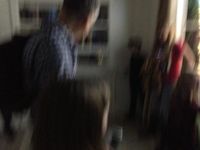 Earthquake
Earthquake
After learning about the science behind earthquakes including plate tectonics, you can watch a short video about how earth land masses have evolved, and then experience the 1906 and 1989 earthquakes for yourself!
Here we are “being moved” by an earthquake simulation. The exhibit sparked all sorts of questions fro the girls: Was I was in California for the 1989 earthquake? (yes) Did I feel it? (yes) What did I do? (stood under doorway)
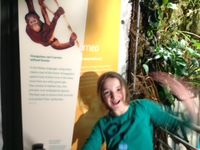 Rainforests of the World
Rainforests of the World
A living four-story rainforest set in a 90-foot diameter glass dome. You can follow a circular path up through the exhibit and experience what it’s like be in a real rainforest in Borneo, Madagascar, Costa Rica and the Amazon. Temperatures are maintained at 82-85 degrees Fahrenheit, and humidity is maintained at 75% via a misting system.
This is a must just to see the butterflies, but this exhibit especially resonated with my oldest, who is writing a school report on Orangutans from Borneo. She learned all about deforestation and how it can lead to extinction.
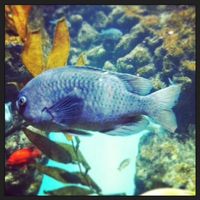 Steinhart Aquarium
Steinhart Aquarium
The Steinhart Aquarium has 38,000 live animals from around the world, representing more than 900 separate species. You can see African penguins, sharks and stingrays, and even a set of teeth on a piranha.
The Rainforest exit lets you off right in the middle of the Aquarium, and we spent some time in the Northern California Coast Gallery exhibits, and then stopped in the Discovery Tidepool so the girls could touch a starfish!
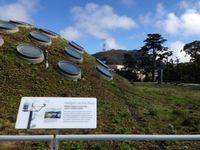 Living Roof
Living Roof
This is one of my favourite places to visit. It’s always nice to escape the buzz of the indoor exhibits and go outside into the bright sunshine, and it’s amazing to discover the museum roof is a 2.5 acre expanse of native California plants and a habitat for bees, birds, butterflies and other wildlife.
 Foucault Pendulum
Foucault Pendulum
Need proof that the earth spins? The Foucault Pendulum is a giant swinging sphere, where the force of gravity keeps the ball swinging back and forth while the planet spins. The pendulum paths moves ever so slightly with each rotation and knocks down pins. It’s fascinating.
My girls can spend hours (OK, minutes) gazing at this from all aspects waiting for the pins to be knocked down.
Morrison Planetarium
The world’s largest all digital planetarium, which includes commentary from very knowledgeable presenters. Shows recommended from age 7, you need a show pass (available on a first come, first served basis) make sure you pick it up early.
We saw “EARTHQUAKE: EVIDENCE OF A RESTLESS PLANET” which was fabulous and a nice complement to the Earthquake exhibit. Here’s a little preview.
 Dining
Dining
Academy Café offers a multicultural menu designed to appeal to appetites of all ages. Signature highlights include spring rolls, paninis, tacos and fresh pastries.
We picked one station: Noodles! We had BBQ pork vermieclli, pasta wth ham and cheese, and a hot dog. the girls picked fresh lemonade and it was homemade and thirst quenching. We’ve eaten here a few times. The food is consistenly very good, though the lines can be long, slightly confusing and there’s a need for more seating.
There’s also a fine dining option, The Moss Room, which looks fabulous.
Coming soon:
In the excitement leading up to the Americas Cup races, visit Built for Speed, a new exhibit opening on May 10 which explores sailfish, squid and other swift ocean animals.
They also have a cool sleepover programme: Penguins and Pajamas (Why count sheep when you could count geckos, butterflies, sharks, and penguins?)
If you go:
California Academy of Sciences, www.calacademy.org 55 Music Concourse Dr San Francisco, CA 94118 (415) 379-8000 Twitter @calacademy. Admission to the Academy is: $29.95 for adults; $24.95 for youth ages 12 to 17, Seniors ages 65+, and students with valid ID; $19.95 for children ages 4 to 11; and free for children ages 3 and younger. Admission fees include all exhibits and shows. Hours are 9:30 am – 5:00 pm Monday – Saturday, and 11:00 am – 5:00 pm on Sunday.
If you have time:
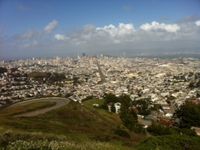 Also visit nearby Twin Peaks, two hills in the center of the city where you can catch FABULOUS panoramic views of San Francisco. It’s a bit windy to get there, but well worth the drive. Don’t bother visiting if it is foogy, you won’t see anything! 501 Twin Peaks Blvd (between Burnett Ave & Christmas Tree Point Rd) San Francisco, CA 94114 FREE. Read the Trip Advisor reviews.
Also visit nearby Twin Peaks, two hills in the center of the city where you can catch FABULOUS panoramic views of San Francisco. It’s a bit windy to get there, but well worth the drive. Don’t bother visiting if it is foogy, you won’t see anything! 501 Twin Peaks Blvd (between Burnett Ave & Christmas Tree Point Rd) San Francisco, CA 94114 FREE. Read the Trip Advisor reviews.


San Francisco: Getting the most out of City Pass | A Modern MotherA Modern Mother | 10th Aug 14
[…] This aquarium-planetarium-rainforest-living museum is one big science lesson – and the kids have so much fun they don’t realise they are learning! The usual price is $34.95 for adults and 24.95 and for kids, 29.95 for youth (12 and up). We always visit the four-story Rainforest (having a butterfly land on your arm is THE COOLEST), the Earthquake exhibit, the Focault Pendulum and the 2 and 1/2 acre living roof. The Aquarium is awesome too, but if you are planning to visit the Monterey Bay Aquarium (one of your options on the pass), you could skim this and spend more time in other areas, like catching a Planetarium show. Here’s my review of the California Science Academy. […]